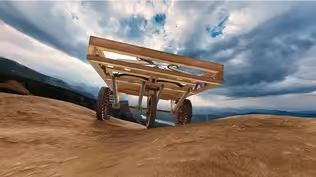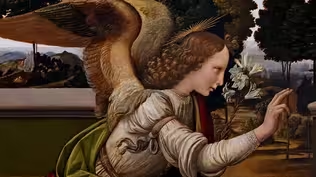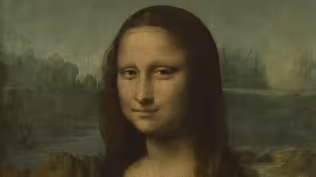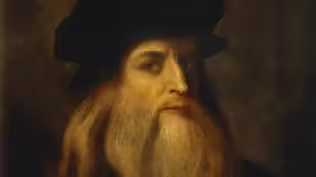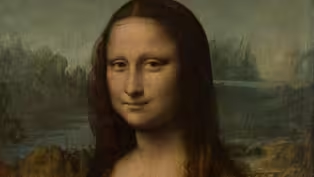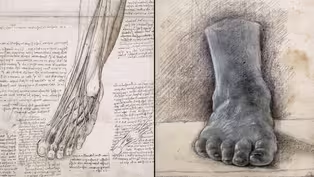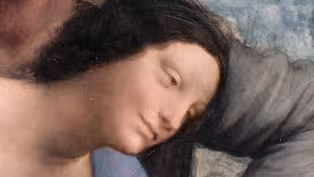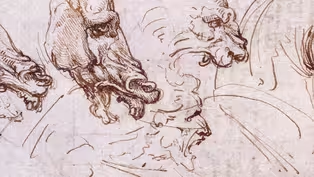
Leonardo da Vinci’s Scientific Experiments
Clip: 11/19/2024 | 9m 53sVideo has Closed Captions
Leonardo da Vinci becomes more of a scientist with age and performs experiments to test theories.
Muslim scientists in the Middle East had been testing their theories with experiments for a long time. However, most natural philosophers in Europe continued basing scientific conclusions on observation alone. But, as Leonardo da Vinci ages, he becomes more of a scientist. His notebooks capture the experiments he performed with empirical observations to investigate the cause of outcomes.
Problems playing video? | Closed Captioning Feedback
Problems playing video? | Closed Captioning Feedback
Corporate funding for LEONARDO da VINCI was provided by Bank of America. Major funding was provided by the Corporation for Public Broadcasting, and by The Better Angels Society and by...

Leonardo da Vinci’s Scientific Experiments
Clip: 11/19/2024 | 9m 53sVideo has Closed Captions
Muslim scientists in the Middle East had been testing their theories with experiments for a long time. However, most natural philosophers in Europe continued basing scientific conclusions on observation alone. But, as Leonardo da Vinci ages, he becomes more of a scientist. His notebooks capture the experiments he performed with empirical observations to investigate the cause of outcomes.
Problems playing video? | Closed Captioning Feedback
How to Watch Leonardo da Vinci
Leonardo da Vinci is available to stream on pbs.org and the free PBS App, available on iPhone, Apple TV, Android TV, Android smartphones, Amazon Fire TV, Amazon Fire Tablet, Roku, Samsung Smart TV, and Vizio.
Buy Now
Providing Support for PBS.org
Learn Moreabout PBS online sponsorshipMan as Leonardo: Before going any further, I shall do some experiments because I intend to first produce the experience and then use reason to prove why the experience is forced to act that way, and this is the true rule whereby those who investigate natural effects must proceed, and, although nature begins with the cause and ends in experience, we must proceed in the opposite sense, in other words, starting from experience and using that to investigate the cause.
Narrator: Though Muslim scientists in the Middle East had long been testing their theories with experiments, most natural philosophers in Europe continued to follow the example of Aristotle, whose scientific conclusions had relied solely on observation.
♪ Gopnik: Leonardo comes of age at a time when the first stirrings of the Scientific Revolution was just being felt.
It progressed by narrowing the problems that it was asking itself.
Leonardo's mind is still elsewhere.
He's trying to think, "What if you looked at it all at once?
How would you solve it?"
But he has the kind of restless curiosity and intellect and the perpetual dissatisfaction with the received solution which are core, kind of the Promethean fire, of the Scientific Revolution, so if we see Leonardo helping to set alight that great adventure, I don't think we're wrong.
Gharib: His early work, definitely his writings, are influenced by Aristotle, but, as he aged, he became more of a scientist.
You could see that his approach was more of a analytical approach, combination of a hybrid of experiments and, you know, the theory.
♪ Man as Leonardo: Force arises from dearth or abundance.
It is the child of physical motion and the grandchild of spiritual motion, and the mother and origin of gravity.
Gravity is limited to the elements of water and earth, but this force is unlimited, and it could be used to move infinite worlds if instruments could be made by which the force could be generated.
♪ He realized that every object at the given height takes the same time to reach the ground.
Very quickly, he realizes there's something called acceleration.
Narrator: Leonardo understood that gravity caused falling objects to accelerate.
Seeking to measure this force, he designed an experiment.
He filled a jar with sand and then emptied it while moving the tilted jar horizontally, increasing his speed as he went.
When the falling sand formed an isosceles right triangle, he knew that the acceleration of his lateral motion matched the acceleration of the falling sand due to gravity.
Gharib: And in his experiments, he tried different accelerations, and he shows the patterns of the sand and then shows that exactly at the moment that he has G, that degree, 9.81 meters per second per second that we know today, he gets exactly the triangle that is here.
Narrator: Leonardo called it the "equalization of motion," and it allowed him to roughly calculate Earth's gravitational constant.
It would be a century before Galileo's experiments proved gravity's universal effect on objects and far longer before Isaac Newton and Albert Einstein would use calculus, not yet invented in Leonardo's time, to define and explain gravity.
[Speaking French] It shows clearly that he had the imagination.
He had the power of, you know, putting an experiment together in order to look at a theory that he had, and that is not something that, you know, you find it in every, even normal, scientist.
For him, it was a burning question to answer, a puzzle that he wanted to understand for himself, and that's what I think is the character of a genius.
Narrator: In a manuscript dedicated to the physical world and its mechanics, Leonardo compiled his scientific observations and theories on geology, astronomy, and especially water.
Kemp: So water was mobile and visible.
You could see what was going on, and he enhanced his abilities to see it.
He set up experimental tanks, and water poured out of a rectangular mouth into this tank, and he used millet seeds to see what's going on in the water to try to understand these things, so water epitomized the movement of nature, but it had the advantage of being mobile, visible, and could be subject to experiment.
Narrator: Natural philosophers as far back as Aristotle had believed that rain could not be the only source of water feeding mountain springs and streams.
In seeking to test their theories, Leonardo turned again to the ancient analogy of the microcosm and macrocosm.
Man as Leonardo: Just as the blood surges upward and pours through the broken veins of the forehead, so from the lowest depths of the sea, the water rises to the mountaintops, where, finding its veins broken, it flows downwards and returns to the sea.
Isaacson: When he tries to form a pattern about how water gets to the top of the mountain and he makes an analogy with our blood, he realizes, "Well, that's not correct," because he tests it out by showing how heated water can move up and down.
Man as Leonardo: The water of the ocean cannot make its way from the roots to the tops of the mountains.
So he went through a lot of different solutions that had been proposed, and he did experiments-- some of them real experiments, we're quite sure, some copied from other places, like the siphoning.
Leonardo made a lot of different sketches, and he thought about what happens and gravity as he thought about it in those times, and it just didn't add up, so he kept on going.
Narrator: Eventually, he concluded correctly that precipitation alone supplied the water that flowed down from mountain peaks.
While studying a valley, Leonardo noticed marine fossils embedded in layers of rock that had been carved by a river over the ages.
For many, the fossils were evidence of the great biblical flood which had inundated the entire planet.
Kemp: He accepts the Bible as a book of revelation and the books of the saints and so on.
He says, "I let be the sacred writings, for they're the supreme truth," but that then frees him, as it were, to describe nature, and he can see that these-- there's evidence that these creatures were living there, actual living colonies.
They weren't just left there by floods, as it were.
Man as Leonardo: You must first inquire whether the deluge was caused by rain or by the swelling of the sea, and then you must show how neither rain nor flooding rivers nor overflowing seas could have caused the shells, being heavy objects, to have floated up the mountains.
[Vecce speaking Italian] Kemp: He concludes that the earth must be very ancient, and that, of course, is a rather challenging idea because it's saying that the earth, if we look at it analytically, isn't something which is made in 7 days, 7 nights.
♪ Guillermo del Toro: Leonardo carries with him all the questions in the world.
The notebooks are a dialogue with the world and a dialogue with yourself, and it doesn't matter if the empirical observation leads to confirmation.
There are many errors there, and not all of them are original ideas.
Of course, he is reworking ideas that come from the past, but I think that the progress of knowledge and the human mind is not a line, is not linear.
It's little revolutions.
Leonardo da Vinci and the Mona Lisa
Video has Closed Captions
Clip: 11/19/2024 | 8m 20s | Leonardo da Vinci spends 14 years working on the Mona Lisa, the culmination of all his knowledge. (8m 20s)
Leonardo da Vinci Investigates the Human Body
Video has Closed Captions
Clip: 11/19/2024 | 7m 22s | Leonardo da Vinci’s study of human anatomy combine scientific exploration with expert artistry. (7m 22s)
Leonardo da Vinci's The Virgin and Child with Saint Anne
Video has Closed Captions
Clip: 11/19/2024 | 7m 45s | Da Vinci’s The Virgin and Child with Saint Anne showcases his scientific and artistic knowledge. (7m 45s)
Michelangelo, Leonardo da Vinci and The Battle of Anghiari
Video has Closed Captions
Clip: 11/19/2024 | 10m 9s | Leonardo da Vinci’s The Battle of Anghiari commission pits him against his rival, Michelangelo. (10m 9s)
Providing Support for PBS.org
Learn Moreabout PBS online sponsorshipSupport for PBS provided by:
Corporate funding for LEONARDO da VINCI was provided by Bank of America. Major funding was provided by the Corporation for Public Broadcasting, and by The Better Angels Society and by...

